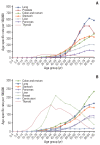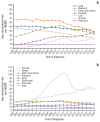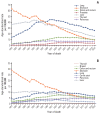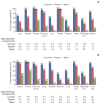Cancer Statistics in Korea: Incidence, Mortality, Survival, and Prevalence in 2020
- PMID: 36915245
- PMCID: PMC10101796
- DOI: 10.4143/crt.2023.447
Cancer Statistics in Korea: Incidence, Mortality, Survival, and Prevalence in 2020
Abstract
Purpose: The current study provides national cancer statistics and their secular trends in Korea, including incidence, mortality, survival, and prevalence in 2020.
Materials and methods: Incidence, survival, and prevalence rates of cancer were calculated using the Korea National Cancer Incidence Database, from 1999 to 2020, with survival follow-up until December 31, 2021. Deaths from cancer were assessed using causes-of-death data obtained from Statistics Korea.
Results: The number of new cancer diagnoses in 2020 decreased by 9,218 cases (3.6%) compared to 2019. In 2020, newly diagnosed cancer cases and deaths from cancer were reported as 247,952 (age-standardized rate [ASR], 262.2 per 100,000) and 82,204 (ASR, 69.9 per 100,000), respectively. The overall cancer incidence rates increased by 3.3% annually from 1999 to 2012, and decreased by 5.0% annually from 2012 to 2015, thereafter, followed by nonsignificant changes. Cancer mortality rates have been decreasing since 2002, with more rapid decline in recent years. The 5-year relative survival between 2016 and 2020 was 71.5%, which contributed to prevalent cases reaching over 2.2 million in 2020.
Conclusion: In 2020, the number of newly diagnosed cancer patients decreased due to the coronavirus disease 2019 pandemic, but the overall trend is on the rise. Cancer survival rates have improved over the past decades. As the number of cancer survivors increases, a comprehensive cancer control strategy should be implemented in line with the changing aspects of cancer statistics. The long-term impact of the coronavirus disease 2019 pandemic on cancer statistics needs to be investigated in the future.
Keywords: Incidence; Korea; Mortality; Neoplasms; Prevalence; Survival.
Conflict of interest statement
Conflict of interest relevant to this article was not reported.
Figures







References
-
- Ferlay J, Ervik M, Lam F, Colombet M, Mery L, Pineros M, et al. Global cancer observatory: cancer today [Internet] Lyon: International Agency for Research on Cancer; 2020. [cited 2023 Feb 6]. Available from: https://gco.iarc.fr/today.
-
- Statistics Korea [Internet] Daejeon: Statistics Korea; 2021. [cited 2023 Feb 6]. Available from: http://kosis.kr.
-
- Siegel RL, Miller KD, Fuchs HE, Jemal A. Cancer statistics, 2022. CA Cancer J Clin. 2022;72:7–33. - PubMed
MeSH terms
Grants and funding
LinkOut - more resources
Full Text Sources
Medical
Research Materials
Miscellaneous

